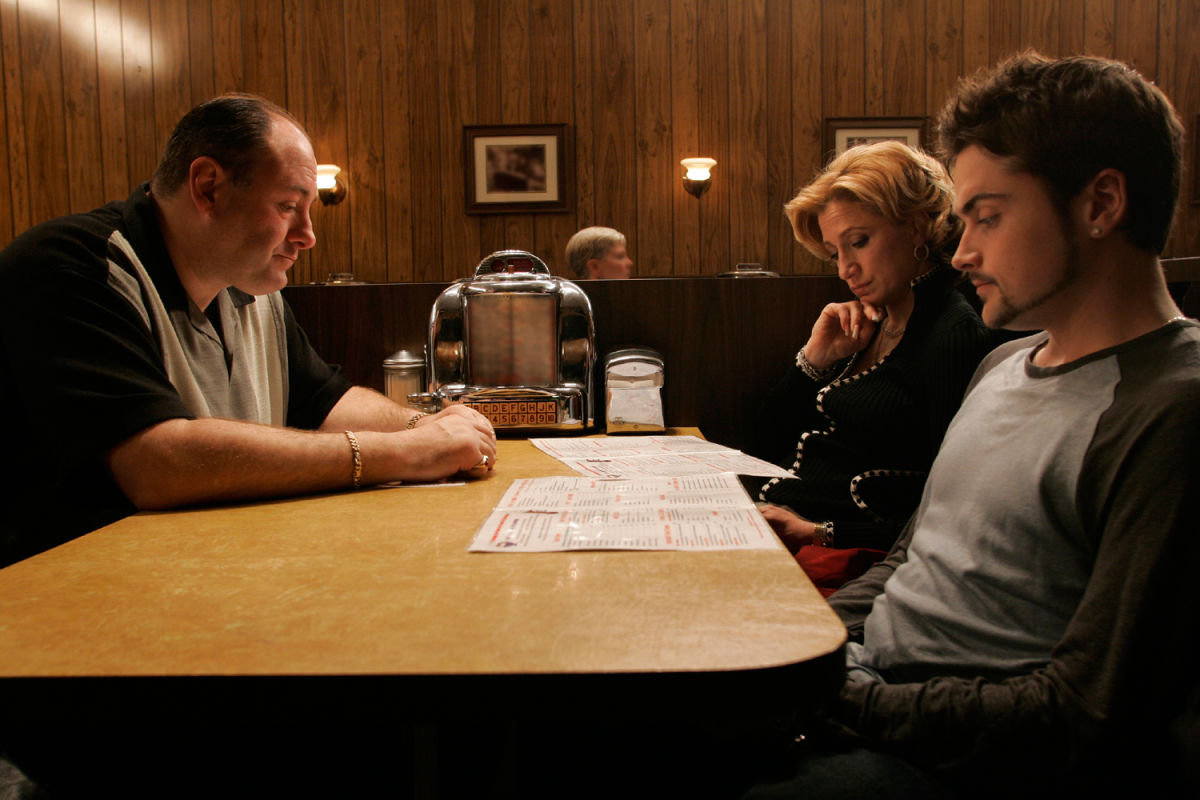Jason Mittell’s new book, Complex TV: The Poetics of Contemporary Television Storytelling (NYU Press, 2015), explores how serial television tells stories,
focusing on the recent trend of increased narrative complexity found within
many contemporary programs. With analyses of innovative 21st century
series like “Breaking Bad,” “The Wire,” “LOST,” “Veronica Mars,” “Curb Your Enthusiasm,” “Dexter,” “Homeland,” “Louie,” “Battlestar Galactica,” and “Homeland,” Mittell considers issues like
authorship, characterization, melodrama, and transmedia tie-ins.
This excerpt from the book
discusses the role of endings in serial television, with an analysis of the
much-discussed but still controversial finale of “The Sopranos.” The finale is still in the news eight years after the
fact, as David Chase’s recently offered a detailed explanation of how he constructed the final scene—while still
refusing to answer the lingering question of Tony’s possible death (despite a falsely reported claim that Chase confirmed that
Tony lived last year).
RogerEbert.com hosted its own discussion of the finale and its significance two years ago. “Don’t stop”
indeed…
Every television series begins,
but not all of them end—or at least not all series conclude. Endings are not
quite a parallel part of the narrative frame to beginnings, a distinction that
carries over linguistically. Begin is
solely a verb, needing to be transformed into the noun beginning, while end and ending work as both nouns and verbs—in
this chapter, I explore the dual meanings of end as both “the final part of something” and “a goal
or result that one seeks to achieve.” In the case of serial television, the
ending is often the ends, or the ultimate target that a series extends toward,
at an unplanned future date. We can learn much about how complex serials work
by considering how they strive toward their final episodes and what happens
when they manage to reach them….

Every series that is no longer in
production has a final episode, but actual finales are quite rare for American television
series, with a range of other, much more common techniques of ending. The most
prevalent form of ending is the stoppage,
an abrupt, unplanned end to a series when the network pulls the plug midseason
(usually in the series’s first season). A stoppage is always extratextually
motivated, usually when a network loses faith in a series’s ratings or
potential for growth or sometimes when a personnel issue with a creator or cast
member creates a crisis, resulting in a premature cessation of a series without
narratively motivated closure or finality. Fox’s 2005 series Reunion is a good example of the perils
of stoppage, with an abrupt cancellation after the airing of nine episodes that
left the central murder mystery unresolved. Fox executives were asked to
explain the planned resolution in press interviews to satisfy fans’ demands,
but they refused to fully reveal what would have happened because the writers still
had not decided how to resolve the open-ended set of possibilities. This
unresolved enigma became a cautionary example for both network executives and
fans about the dangers of complex serialization, as the fear of a premature
stoppage might create reluctance among viewers in sampling a new serial,
worried that it might be canceled without closure or even sufficient narrative
development.
The next category in this spectrum
of closure is the wrap-up, a series
ending that is neither fully arbitrary nor completely planned. Typically,
wrap-ups come at the end of a season, when producers have come to a natural
stopping point but without planned series finality. For programs with seasons
that are crafted with a planned unity and internal structure, such as Veronica Mars, each season’s end could
serve as the series wrap-up, but none offer a clearly conclusive end to the
story—the fact that season 3’s final episode was the last of the series was not
narratively motivated, as a teaser was even shot for a potential fourth season,
set in the FBI academy, and years later a feature film was produced to continue
the story, disregarding the FBI plotline as noncanonical. Cable programs with
shorter seasons often treat every season finale as a potential series wrap-up,
as single-season programs such as Terriers
and Rubicon both ended with a degree
of closure but not outright finality. On such series, the majority of a
season’s episodes have typically been written before the series begins to air,
so a single season of 10–13 episodes is treated as a narrative unit with a
possible wrap-up but with enough open-ended threads that potential renewal
feels desirable and motivated. As Greg Smith describes such seasons, they wrap up
with “punctuation marks” of climactic narrative events and partial resolution
but with “game changers” that set up the possibility for a new narrative
direction if the series gets renewed.[1]
Less common still is the conclusion, when a program’s producers
are able to craft a final episode knowing that it will be the end. Sometimes a
conclusion is planned in advance by the producers, and sometimes it is thrust
on them—compare Joss Whedon’s pair of programs, with Buffy’s seventh season planned as its last from the season’s
beginning, while Angel was canceled
in midseason, leaving Whedon to rework the final set of episodes to offer a
somewhat rushed last-minute conclusion. For the single-season series Last Resort, the producers were told
that it would be canceled with enough lead time to make a final episode with a
good deal of narrative finality, while Pushing
Daisies was merely able to tack on a concluding epilogue to the
season-ending episode upon notice of cancellation. Conclusions offer a sense of
finality and resolution, following the centuries-old assumption that
well-crafted stories need to end; however, such resolutions are comparatively
rare for American television; the industry equates success with an infinite
middle and relegates endings to failures. This tension between narrative and
economic impulses can create conflicts, as with Lost’s challenges in early season 3, as the producers reflected
that they were forced to “tap-dance” to delay narrative progress without a
sense of when they could start implementing their planned endgame—midway
through the season, they negotiated an unprecedented specified end date three
seasons into the future, allowing them to plan toward an eventual finale and
craft a noninfinite middle for the remaining seasons.[2]
There are a few variations on these
possibilities. One is a cessation,
which is a stoppage or wrap-up without a definite finality that it will be the
end of the series. It is fairly common for a series to go on hiatus midseason,
leaving its narrative future in limbo until it either returns to the air or
disappears from next year’s schedule. Less common is the series that wraps up
at the end of the season but is left ambiguously uncertain about future return;
the most high-profile example of such a cessation is Deadwood, which was denied its planned final fourth season,
morphing into unmade-for-TV movies that were long discussed as if they might
someday be produced. A cessation is lodged at the crosshairs intersecting
creativity and commerce, as storytelling progress is held in check by the
bottom line of profitability, leaving the narrative world in a state of
perpetual limbo and awaiting a possible return.
The inverse of a cessation is a resurrection, when an already concluded
series returns, either on television or in another medium. Some programs are
resurrected after being cut short through cancellation after stoppages or
wrap-ups, as with Firefly being
reborn as the feature film Serenity,
while other series return postconclusion as ongoing comics, as with Whedon’s
other programs Buffy and Angel—in all of these instances, the
motivation seems to be having more stories left to tell and the freedom to tell
them differently in another medium. Commercial imperatives can also override
creative goals when a series is resurrected despite the wishes of the
producers, as with Scrubs’s return
for a ninth season despite the conclusiveness of season 8’s episode “My
Finale.” A series can also hover in between cessation and resurrection, as
wrapped-up programs such as Arrested Development
and Veronica Mars had been frequently
discussed as spawning feature films for years after their cancellations, but it
was not until 2013 that both were resurrected, with the former getting a fourth
season on Netflix and the latter leveraging Kickstarter to produce a feature
film.
Finally, we have the finale, which is a conclusion with a
going-away party. Finales are defined more by their surrounding discourse and
hype than any inherent properties of the narrative itself, as they feature
conclusions that are widely anticipated and framed as endings to a beloved (or
at least high-rated) series. Finales are not thrust on creators but emerge out
of the planning process of crafting an ongoing serial, and thus the resulting
discourses center around authorial presence and the challenges of successfully
ending a series. Such conclusions are often presented embedded within a set of
paratexts, with high-profile press features and interviews, televised specials
offering retrospectives, and the promise of eventual DVD extras that will add
even more weight to the final episode. Such discursive prominence of finales
raises the narrative stakes of anticipation and expectation for viewers, and
thus finales frequently produce disappointment and backlash when they inevitably
fail to please everyone.
As with most aspects of American
television, public awareness of industry practices of ratings, scheduling, and
seasonal renewal or cancellation has grown more prominent in the Internet era,
as fans can track the potential futures of their favorite programs as well as
consume hype around a planned finale. The knowledge of a series’s upcoming
finale recasts fans’ expectations for the final season and potentially serves
to overshadow the various ways fans have engaged throughout a long-running
season, with the enormous weight of needing to “stick the landing” for a final
conclusive episode. Three high-profile finales and their corresponding final
seasons provide key insights into some of the strategies of conclusion that complex
television uses to come to an end and the ways that viewers engage with such
endings: The Wire, Lost, and The Sopranos.
…
For both Lost and The Wire, the
atypical storylines and structures of their final seasons are best appreciated
as reflections in their own narrative mirrors. But why do serials seem to
embrace the meta so often in their final seasons? In part, creators seem to
become hostages to their own storyworlds, so embedded in the process of
storytelling that they feel the need to use fiction as an outlet to explore
their own processes of letting go of their narratives, as well as to offer
closing arguments for the relevance and missions of their programs. This
connects to the role of hype in promoting finales and generally fueling ongoing
serial narrative—unlike stand-alone fictional forms such as films or novels,
the creative processes of serial television occur in parallel with viewers’ and
critics’ reaction. Hype and reception discourses help shape expectations for
both viewers and creators, and thus the pressure to stick the landing seems to
matter more for an ongoing serial. The metafictional finale is a key example of
how producers come to terms with the ends of their storyworlds as shaped by
years of cultural circulation and conversation that are unique to the serial
form. And no finale generated more conversation and debate than the landmark
HBO series The Sopranos.
He’s Dead to Me: Debating the Ending of The Sopranos
On June 10, 2007, The Sopranos legendarily ended with a scene of Tony’s immediate family eating in a diner
and listening to the Journey song “Don’t Stop Believin’,” before cutting to a
silent black screen for 10 seconds preceding its final credits. This edit is a narrative special effect played in
reverse, an antispectacle offering a moment of spectacular storytelling. If
traditional special effects push screen and sound systems to their limits, this
cut to black suggested technological failure, inviting many viewers to surmise
that their cable had gotten disconnected or their televisions had died at the
least opportune moment. This moment of dead air was certainly the most analyzed
and debated edit in the program’s history and one of the most contentious
endings in television history. Looking at the sequence and the debates it
inspired helps explain the functions of finales and The Sopranos’s role in contemporary television storytelling.
As a whole, The Sopranos is less immersed in the culture of forensic fandom and
online television debate than many other programs discussed in this book. In
large part, this stems from its casual attitude toward serial plotting; as
discussed in chapter 1, the series embraces more episodic plots than most prime
time serials and often allows itself to pursue digressions and fantasy
sequences in lieu of narrative enigmas, mysteries, or even plot-driven
curiosity questions. More than most complex television series, The Sopranos invites interpretation for
theme or symbolism but not the mysteries, structural games, or serial builds
toward narrative climaxes that typify many comparable dramas with more robust
online fan bases. Thus it is quite surprising that the last scene in the entire
series prompted such an outpouring of forensic fandom trying to discern what it
meant in terms of both basic narrative comprehension and thematic significance.
And appropriately as this book’s conclusive case study, the analysis takes us
back to the most basic concept of narrative analysis that was discussed in the
introduction: the distinction between story and narrative discourse.
Much of the motivation to
understand the finale was driven by the episode’s status as a highly hyped
finale, with viewers knowing full well that the series was ending and thus
expecting a conclusive sense of finality or at least some closure, rather than
the ambiguous and open-ended cut to black that “Made in America” delivered. It
was not surprising that the final scene took place over a family meal, as the
first three season of The Sopranos
similarly concluded with somewhat anticlimactic moments of familial dining;
what was surprising was that rather than fading to black or offering a
memorable final image, the only violence portrayed was to the typical formal
devices of television editing, as the midmoment cut to silent blackness felt
like a violation of the medium’s norms and expectations. Since serial
storytelling thrives on the gaps between episodes to encourage conversation and
interpretation, the lack of a next chapter after such an unusual moment
encouraged viewers to fill the lack of forthcoming storytelling and authorial
explanation with their own speculations and analyses. Even though the final
season of The Sopranos did not
embrace metastorytelling as much as Lost
and The Wire did, this final moment
encouraged viewers to reassess how the narrative had led to this point and what
it might mean at the level of both story and discourse.
Viewers developed a range of
explanations to make sense of this unconventional ending. The most immediate
reaction seems to have been an assumption of technical failure, such as broken
televisions or disconnected cable; while obviously incorrect, this is also a
justified reaction, as such an extreme violation of media norms leads people to
assume that it was some sort of error, not a choice to intentionally break the
rules. Of course, it is an intentional edit, not an arbitrary one, occurring
precisely as Tony looks up to see Meadow entering the diner (presumably) and as
the Journey song offers the lyrics “don’t stop” one last time. Notably, creator David Chase wanted to end the episode with
30 seconds of blackness, eliminating
all credits until the final HBO bumper, but both HBO and the Directors Guild
vetoed the idea of forgoing closing credits. Instead, the 10 seconds of black
served as enough of a gap to create technological panic among viewers but
without eliminating all vestiges of a normal episode ending. Chase’s desire to
extend the black screen does suggest that the blackness signifies something,
not just demarcating the end of the story—a distinction that becomes crucial
for subsequent debates over the ending.
Once a viewer realizes that the
black screen is not a technical glitch but an artistic choice, the key question
in order to make sense of The Sopranos’s
ending is whether the cut to black signifies anything within the storyworld
itself or just at the level of storytelling. There is no doubt that it is
significant at the level of narrative discourse, signaling the end of the
program’s active narration and manifesting an absence of audio and visual
information to cue viewers that there will be no more storytelling to come.
This absence is so provocatively asserted that it needs to be understood and
analyzed as a shot itself, a presence of nothingness rather than a default null
state lacking content and form. In the abrupt shift from Tony to blackness,
from Steve Perry’s singing voice to silence, nothing happens overtly at the
level of story; however, at the level of storytelling, this “nothing” happens
actively and insistently—we notice this nothingness, with the sequence rubbing
our noses in the interminable gap between images of Tony and the first credit.
So what does the nothingness mean?
Following ideas explored in chapter
3, we might attribute this moment to a distinct message from David Chase, or at
least our notion of Chase as the text’s inferred authorial function, to his
viewers: many took the ending as a direct attack on viewers’ desire for
closure, justice, or a moral message, providing instead a lack of a conclusion
out of a spiteful contempt for norms of narrative pleasure and television
viewing expectations. Although Chase has been oblique in discussing the finale,
he has vehemently denied that he would use his final moment to be contemptuous
or audacious toward the audience but rather has insisted that his goal was always to
“entertain them.” Nonetheless, the
choice to violate the norms and expectations of television storytelling was
interpreted by many people as an audacious and aggressive “screw you” to
viewers and their preconceived notions of closure, rather than providing what
fans had come to expect throughout the series.
A variant on the reading of the
abrupt cut as an act of aggression against fans is to frame it as a rupture to
viewing norms, not out of contempt for viewers but to get them to feel the
ending as a sudden demise through the episode’s sudden cessation. As critic Matt Zoller Seitz sums up this position, “The lack of resolution—the absolute and
deliberate failure, or more accurately, refusal, to end this thing—was exactly
right. It felt more violent, more disturbing, more unfair than even the most
savage murders Chase has depicted over the course of six seasons, because the
victim was us. He ended the series by whacking the viewer.” Under this
interpretation, any concluding moment in a story is as arbitrary as the next.
There is always more story to tell, and any conclusive ending is an illusion;
thus the decision to end in the midst of the diner sequence is as valid as any
other: abrupt and jarring but ultimately no less conclusive than any other
arbitrary “resolution.” In other words, it is a way of stopping, but not
ending, the story, via an abrupt end to the storytelling. Taken to a broader
level, this is a bold critique of the arbitrary structures of serial narration
and a refusal to comply with the medium’s expectations and norms, a skeptical
attitude toward television that The
Sopranos consistently offered. The ending’s arbitrariness stems from how
the narrative stoppage is not connected to any event in the storyworld, as the
scene is framed as uneventful despite the sense of menace and danger produced
by taut editing coupled with viewers’ expectations that the final moment is
pending. The key action is at the level of narrative discourse, where the
violent act is committed at the cost of viewers’ knowledge and
comprehension—Tony’s story could continue in a wide range of possibilities, but
we are not able to experience it anymore after we are “whacked.” It is an act
of aggressively ambiguous storytelling, refusing any clarity or motivation
concerning what happens subsequently in the story.
Of course, another widespread
interpretation does argue that the cut to black is motivated by story events:
namely, that we are witnessing Tony’s death from his point of view. This
analysis has been promoted by many viewers, most notably in copious detail by
the pseudonymous “Master of Sopranos” in his epic forensic fan blog called “Definitive Explanation of ‘The End.’” In more than 45,000 words, Master of Sopranos
attempts to prove, without any ambiguity, that “Tony’s death is the only ending
that makes sense.” This argument relies primarily on formal analysis of
continuity editing to suggest that the cut to black is Tony’s point of view
upon being shot in the diner, supported by thematic and symbolic markers found
throughout the episode and numerous cues earlier in the season that frame death
as a surprise absence, such as Bobby’s twice-repeated line “You probably don’t
even hear it when it happens.” The argument is so detailed and well supported
that it is hard to imagine reading it and not being convinced that if there is
a story motivation for the final edit, it is only explicable as Tony’s final
moments of life.
The reason why the debate continues
years after the episode aired is because some people find the attempt to be so
“definitive” in an explication to be working against the ambiguity that Chase
seems to have designed as the finale’s legacy—as the critic Todd VanDerWerff suggests, accepting this interpretation “robs the mystery
out of a series that was always replete with it, and it forces things that
could mean many things to mean only one thing.” The series as a whole embraces
ambiguity and openness to thematic interpretation and occasionally a lack of
narrative clarity as to what precisely happened, so attempting to be definitive
does seem counter to its intrinsic norms. However, the final moments of any
finale are clearly atypical, as a conclusion always begs further reflection,
contemplation, and, in the case of such ambiguity, analytical interpretation.
There is no doubt that the final sequence is designed to be nonobvious in its
meaning; the lingering question is whether it can be read as obliquely
suggesting a conclusive set of narrative events (Tony’s death) or must remain
openly ambiguous with the cut to black belonging solely to the level of
narrative discourse.
Personally, I do interpret the
final sequence as portraying Tony’s death, although not with the “definitive”
weight that some forensic fans insist on, but with the oblique presentation
adding to its narrative effect. For advocates of ambiguity, such as VanDerWerff
and Seitz, the moral ethos of The
Sopranos points away from the rendering of a final death. Seitz writes,
“Chase spent eight years railing against films and TV shows about violent
criminals that absolved viewers of feelings of guilt and complicity by showing
the hero being led away in handcuffs or shot down in the street. Why would he
then reverse course in the final moments of the final episode and kill Tony?
And if what we were looking at was indeed a killing of that specific character,
why was it presented in an arty, confusing way?”[3] However, I
contend that the scene’s oblique narrative form of presenting Tony’s murder
works to avoid this moral conundrum by distancing viewers from such emotional
reactions, which Chase clearly worked to avoid.
The “arty, confusing” presentation
avoids the trap that Seitz articulates: if we saw Tony’s death, we could
absolve ourselves from years of witnessing his atrocities and even revel in the
blood lust as a sense of retribution. If we saw Tony’s body, some viewers might
feel moral superiority over the fallen criminal, while others might experience
grief for our protagonist or pity for his family witnessing the
assassination—but none of these emotional responses fit with the ambiguous
attitude the series had fostered toward the main character. Instead, we feel no
emotional reactions to Tony’s death because we do not even realize that it
happens until after analytic reflection and analysis. We arrive at the
realization of his death at an analytic distance so that we are not emotionally
tied up in the storyworld: we are not present in the diner with the family and
thus do not experience their moment of loss. We have already had a moment of
mourning, but the grief is over the loss of the series, not the character. Viewers experience The Sopranos as less morally ambiguous than the character of Tony
Soprano, and thus we can feel grief and loss over the end of the series without
either being complicit in or feeling moralistically superior toward Tony’s
crimes.
The abrupt termination of the
series and Tony’s life distances us from the storyworld by keeping us at the
meta level of narrative discourse, and it is there that we experience the five
stages of grief: we deny the ending by blaming it on the cable company; we grow
angry at Chase for denying us closure; we bargain by seeking out clues and
rational explanations; we become depressed that there is no clear answer
forthcoming; we accept the inevitable that the series has ended and that life
(and television) must go on. Our emotions are focused at the level of the
inferred author Chase and his storytelling, not Tony and his story. This is
Chase’s ultimate victory, as he managed to kill off his hero without allowing
the audience to fall into any conventional emotional traps, but still create a
visceral and engaged emotional reaction to the finale.
Or perhaps he did not, and Tony’s
story continued after the storytelling stopped. The risk of The Sopranos’s experimental ending was
that it teased the possibility that conclusions do not matter, that they are
arbitrary and ambiguous rather than final and conclusive—HBO threw a party for
the series finale, but the guest of honor disappeared before the celebratory
toast. Some viewers embraced that openness and refusal to conclude, while
others sought a sense of narrative clarity amid the ambiguity. Either way, the
finale highlights the degree to which endings matter in serial television,
serving as the lasting image (or lack thereof) that will be remembered and
discussed long after the rest of the series fades from memory.
Jason Mittell is Professor
of Film & Media Culture and American Studies at Middlebury College,
Vermont. He is the author of Genre and
Television: From Cop Shows to Cartoons in American Culture (Routledge,
2004), Television and American Culture
(Oxford University Press, 2009), Complex TV: The Poetics of
Contemporary Television Storytelling, and co-editor with Ethan Thompson of How to Watch Television (NYU Press, 2013). He writes the blog Just TV.
Copyright 2015 by Jason
Mittell. Excerpted with permission of New York University Press.
[1] Greg
M. Smith, “Caught between Cliffhanger and Closure: Potential Cancellation and
the TV Season Ending” (paper presented at the Society for Cinema & Media
Studies conference, New Orleans, Louisiana, 2011).
[2]
Personal interview with Carlton Cuse and Damon Lindelof, March 23, 2010.
[3] Matt
Zoller Seitz,“The Sopranos,” Sight &
Sound 23:9, September 2013, 112.











